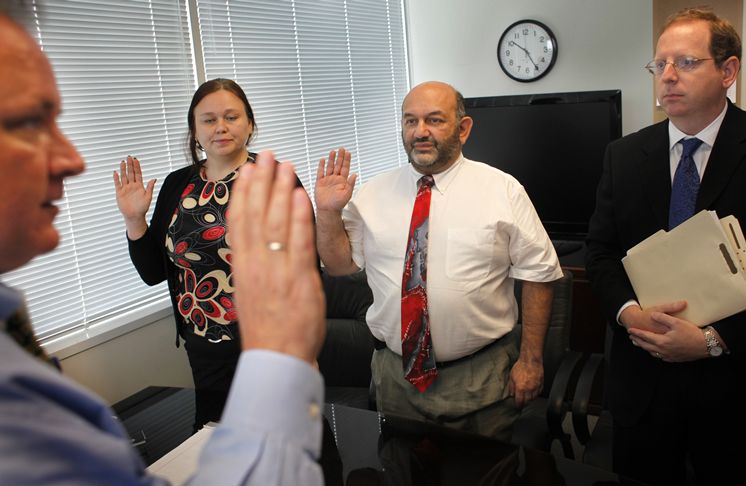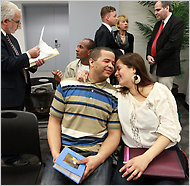
It is possible to avoid the dreaded I-751 interview. No couple wants to visit U.S. Citizenship and Immigration Services (USCIS) to be prodded with personal questions about their marriage. What’s more, the stakes are high. If USCIS isn’t convinced that you have a bona fide marriage, the conditional resident’s status may be in jeopardy.
As a matter of law (INA §216) a couple must appear for a personal interview in order for USCIS to remove the conditions on residence. But if USCIS is thoroughly satisfied that you did not marry for the purpose of evading the immigration laws, they may waive the interview and approve the I-751 petition. Let’s help you avoid the I-751 interview all together.
USCIS Determines the Need for an I-751 Interview
The former USCIS Adjudicator’s Field Manual and more recently issued policy memo provide guidance to USCIS officers on when to consider waiving the interview requirement for Form I-751. This policy memo applies to all I-751 petitions received on or after December 10, 2018. USCIS officers may consider waiving an interview if they are satisfied that:
- They can make a decision based on the record because it contains sufficient evidence about the bona fides of the marriage and that the marriage was not entered into in order to evade U.S. immigration laws;
- USCIS has previously interviewed the principal petitioner (through the consular or adjustment interview process);
- There is no indication of fraud or misrepresentation in the Form I-751 or the supporting documentation; and
- There are no complex facts or issues that require an interview to resolve.
Initial Review
Initially, a USCIS Service Center will review your I-751 petition. If fully satisfied that the marriage was not for the purpose of evading the immigration laws, the Service Center may waive the interview and approve the petition. However, if they determine an interview is necessary, the case is sent to the Service Center’s Adjudications Unit and given to an adjudicator to assign a fraud level. Subsequently, they assign a fraud level of A, B, or C to your case. The adjudicator uses documentation you submitted with the I-751 petition to make this determination.
Fraud Level Assigned
If the adjudicator is fully satisfied that the case can be approved, then a fraud level of C is assigned. However, if the adjudicator is less than fully satisfied, but still feels that (based on the information available at the time) the case can be approved, then a fraud level of B is assigned. Finally, if the adjudicator has serious concerns about the approvability of the case and/or wants the applicant and the spouse to be interviewed, then the case would be assigned a fraud level of A.
LEVEL C | Reasons for Assigning Fraud Level CIf assigned a fraud level C, it means that there are no technical problems (signatures, missing information, lack of evidence, etc.) and the USCIS adjudicator thinks the case can be approved (no interview necessary). All required supporting documents are attached and there is no indication of fraud or misrepresentation that can be identified in the documents or through the biographic data of the parties involved. |
LEVEL B | Reasons for Assigning Fraud Level BFraud level B cases have no technical problems that need correction and have the minimum number of proper supporting documents, but there is something, or an absence of something that creates suspicion about the bona fides of the marriage, the veracity of the evidence, etc. The reasons for suspicion are so varied that a concise list cannot be made. An example would be where the I-751 is supported by the minimum required number of documents, however the documents are all of recent origin. |
LEVEL A | Reasons for Assigning Fraud Level AUSCIS may assign fraud level A when the adjudicator strongly suspects fraud. Reasons USCIS might assign fraud level A include:
|
Once USCIS determines the fraud level, they send the case to the field office in your area. The field office assigns a percentage to each fraud level. USCIS will interview all level A cases. The field office may choose to interview between 30% to 100% of all level B cases; and between 10% and 50% of all level C cases.
In summary, this means that a very well-prepared I-751 petition will likely avoid the I-751 interview. But the field office may randomly select even some strong cases for an interview.
How Conditional Residents Can Avoid the Interview
USCIS determines the need for an I-751 interview, and USCIS has discretion to waive the interview. But there are things you can do to greatly improve your chances of avoiding it.
File a Well-Prepared Form I-751 Petition
Remember, the purpose of conditional residence is to prove that you entered marriage with the genuine intent to stay married together. If there is insufficient evidence to prove a bona fide marriage or there are circumstances that raise questions about your marriage, USCIS is more likely to schedule the interview.

In fact, even waiver cases (petitions not filing jointly) may be approved without an interview when they are accompanied by sufficient supporting documentation to establish the bona fides of the marriage. Keep in mind, waiver cases are more complex and require additional documentation to establish eligibility for the requested waiver. CitizenPath recommends that you speak to an attorney before filing Form I-751 with a waiver.
First, prepare Form I-751, Petition to Remove Conditions on Residence. You may download the form and filing instructions from the USCIS website, or use CitizenPath to help you prepare the form in about 20 minutes. Designed by immigration attorneys, the CitizenPath website guides users through Form I-751 with step-by-step instructions and even alerts users when there’s a problem. Try it for free.
Submit Strong Evidence of a Bona Fide Marriage
Next, gather evidence indicating that the marriage upon which you were granted conditional status was entered in “good faith” and was not for the purpose of circumventing immigration laws. Submit copies of as many documents as you can to establish this fact and to demonstrate the circumstances of the relationship from the date of marriage to the present date, and to demonstrate any circumstances surrounding the end of the relationship, if it has ended. We’ve compiled a list of 33 great documents for proving a bona fide marriage.
Example Evidence
The supporting documents may include, but are not be limited to, the following examples:
- Birth certificate(s) of child(ren) born to the marriage.
- Lease or mortgage contracts showing joint occupancy and/or ownership of your communal residence.
- Financial records showing joint ownership of assets and joint responsibility for liabilities, such as:
- joint savings and checking accounts with transaction history
- joint credit card statements
- insurance policies that show the other spouse as the beneficiary
- joint Federal and State tax returns
- joint utility bills
- title of car showing joint ownership
- other joint loans
- Any other documents that you consider relevant to establish that your marriage was not entered for the purpose of evading U.S. immigration laws.
- Affidavits sworn to or affirmed by at least two people who have known both of you since your conditional residence was granted and have personal knowledge of your marriage and relationship. Learn How to Write an I-751 Affidavit.
- 10-20 photographs of married couple together. Examples could include wedding photos, traveling, special events with family and friends, etc. (You should also hand write the place, names and dates on the back of photos.)
Above all, financial and insurance records can be some of the strongest evidence that you have a bona fide marriage. Sharing ownership of assets and responsibility for financial obligations is a good indicator that a couple plans to remain together and build a life.
As you can see, your best strategy to avoid an I 751 interview is to prepare a strong I-751 petition with overwhelming evidence to prove a good faith marriage. You want the USCIS Service Center to quickly approve your petition instead of forwarding it to the field office.
RECOMMENDED: What Happens After Filing the I-751 Petition
How to Prepare for the Form I-751 Interview

This article assumes that you have filed the I-751 petition jointly with your spouse and you continue to remain a married couple. If you filed I-751 petition with a waiver (for any reason) or filed jointly and have since split up, CitizenPath recommends that you contact an experienced immigration attorney before attending the I-751 interview. These cases are more complex and require special consideration and strategy from a legal expert.
Nonetheless, there are some best practices when preparing for the I-751 interview:
Gather Supporting Evidence of Your Good Faith Marriage
If you prepared a strong I-751 petition to prove a good faith marriage when you originally filed, you should have kept a copy of these documents. Shared bank accounts, shared financial responsibilities, travel records, wedding records, and children born into the marriage help support your bona fide marriage. If you have new evidence, you may take it to the interview (in case you need it).
Dress Formally
Formal dress communicates that you take the interview seriously. Dress as if you are going to the church or a job interview.
Arrive Early to the I-751 Interview
Get to the interview location a half an hour ahead of the scheduled time. Avoid rescheduling the interview unless it is absolutely necessary.
Be Honest and Open about your Relationship
The USCIS officer will likely ask questions about how you spend your lives together. For example, the officer may ask you how you celebrated a spouse’s birthday, what foods he or she enjoys, and what your spouse’s friends are like.
The I-751 interview will likely dive into some very personal issues about your marriage. If you are a private person, or if you are from a cultural background where talking about relationship issues is somewhat taboo, you may want to prepare yourself by talking to a friend or relative. Although this is not a complete list, and some of the subjects may not be covered at all, here is a list of some topics that you should be prepared to discuss:
- How and where you met your spouse
- Your relationship with your spouse’s family
- The length of your courtship
- How you spend time together
If your I-751 petition package did not include sufficient evidence of shared financial and/or insurance records, you should expect USCIS to ask why. If the couple doesn’t live together, USCIS will want to know more. In many cases, couples have very reasonable explanations.
As long as you are honest throughout the process, you’ll have no problem answering the interviewer’s questions.
Stokes Interview
Couples that sufficiently document their bona fide marriage will avoid the I-751 interview or pass the initial interview. However, USCIS may schedule a “Stokes interview” when there is some concern about the legitimacy of the marriage. That’s why this meeting is also known as a marriage fraud interview.
This is also a second chance for the couple to convince the USCIS officer that the marriage is genuine. The Stokes interview is serious business. The appointment may last most of the day. The spouses are generally separated and questioned individually. The USCIS officer will compare answers and provide further questioning for discrepancies.
The petitioners’ inability to demonstrate the marriage’s authenticity could result in a denial of Form I-751. This leads to removal proceedings for the foreign spouse. If USCIS schedules you for a Stokes interview, we recommend that you work with an immigration attorney to develop a strategy and gather solid evidence of your bona fide marriage.
Improve Your Chances of Skipping the Interview
CitizenPath provides simple, affordable, step-by-step guidance through USCIS immigration applications. Individuals, attorneys and non-profits use the service on desktop or mobile device to prepare immigration forms accurately, avoiding costly delays. CitizenPath allows users to try the service for free and provides a 100% money-back guarantee that USCIS will approve the application or petition. We provide support for the Petition to Remove Conditions on Residence (Form I-751), the Citizenship Application (Form N-400), and several USCIS immigration forms.
Note to Reader: This post was originally published on August 25, 2015, and has been modified with improvements.
Want more immigration tips and how-to information for your family?
Sign up for CitizenPath’s FREE immigration newsletter and
SAVE 10%
on our immigration services



